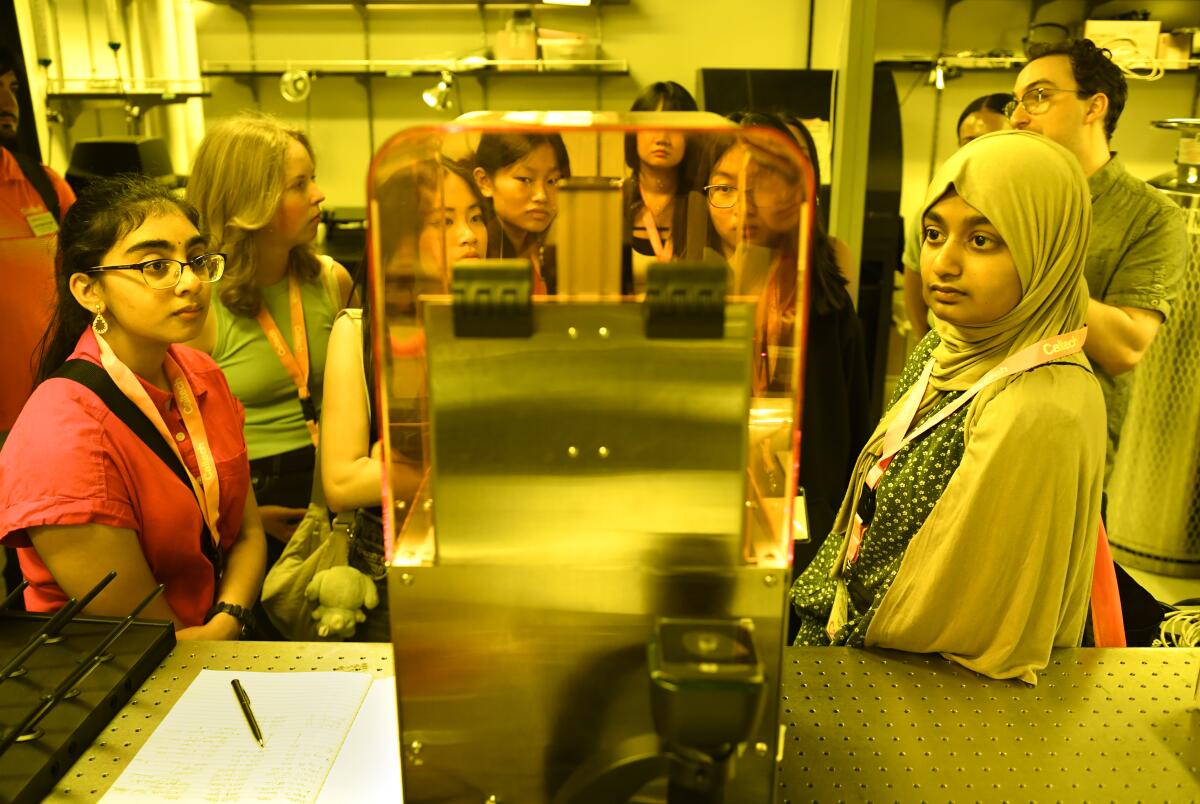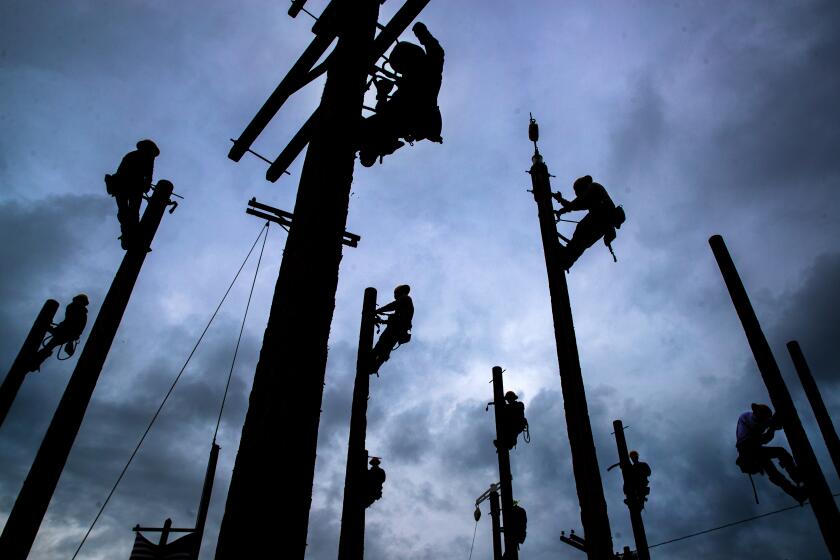No high school calculus, chemistry, physics class? Caltech has a new admission work-around

- Share via
Kimberly Miranda is the brainy daughter of Guatemalan immigrants and the first in her family to attend college. But she almost didn’t make it to the California Institute of Technology.
Her Redwood City school didn’t offer algebra in eighth grade, which threw her off the progression of high school math classes leading to calculus — a long-standing Caltech admission requirement. Miranda managed to double up on math courses in sophomore year to reach calculus as a senior, but not all students have the wherewithal — or support — to take that path.
And scores of students don’t even have that chance, because more than one-third of the nation’s high schools don’t offer calculus, and many also lack physics and chemistry classes, two other Caltech admission requirements. For years, the institute, a global powerhouse of science, technology, engineering and math education, fielded hundreds of calls each year from distraught students and parents about the issue. But Caltech held firm, making no exceptions, even for “absolutely astounding” applicants, as one faculty member put it.
Now Caltech, in the name of equity, is shifting gears. In a groundbreaking step, the campus announced Thursday that it will drop admission requirements for calculus, physics and chemistry courses for students who don’t have access to them and offer alternative paths to prove mastery of the material.
“Brilliant students exist in every single part of this world and in every single community, and this idea that families have to choose the future of their kids and where they’re going to go for college based on their ZIP Code seemed so unfair,” said Ashley Pallie, Caltech’s executive director of undergraduate admissions. “We need to continue opening this door of opportunity.”

One of Caltech’s alternative paths is taking Khan Academy‘s free, online classes and scoring 90% or higher on a certification test. Sal Khan, academy founder, said Caltech’s action is a “huge deal” for equitable access to college. While Caltech is small — only 2,400 students, about 40% of them undergraduates — Khan said he hoped its prestigious reputation would encourage other institutions to examine their admission barriers and find creative solutions to ease them.
The Pasadena-based institute, with a 3% admission rate last year, boasts 46 Nobel laureates and cutting-edge research in such fields as earthquake engineering, behavioral genetics, geochemistry, quantum information and aerospace.
“You have one of the most academically rigorous schools on the planet that has arguably one of the highest bars for admission, saying that an alternative pathway that is free and accessible to anyone is now a means to meeting their requirements,” said Khan, whose nonprofit offers free courses, test prep and tutoring to more than 152 million users.
Even as demand for STEM skills accelerates, federal data for 2017-18 showed that only 65% of public high schools offered calculus that school year. Access to calculus was more limited in large cities and rural areas, where just over half of public schools offered the course. By contrast, 83% of high schools in large suburban areas offered calculus.
Chemistry classes were offered at 88% of high schools, and physics, 74%.
Data from 2015-16 from the U.S. Department of Education’s Office of Civil Rights showed a significant racial gap in access to those classes. Only 38% of 26,300 public high schools with high proportions of Black and Latino students offered calculus that year, compared with half of all schools. Access to chemistry and physics classes was similarly more limited for underrepresented minority students.
In addition, students face growing entry barriers to STEM majors in public universities, as demand to enroll in such fields as computer science, business, economics, engineering and nursing outstrips capacity. A Brookings Institution research brief last month reported that three-fourths of 2021 graduates in those high-earning majors at 106 top public research universities faced firm requirements that restrict admissions, such as qualifying grade point averages in prescribed courses — an increase of more than one-third over the last two decades.
Community college graduates in healthcare fields can outearn humanities students even from elite universities such as Stanford, UC Berkeley and UCLA, underscoring how much majors can matter.
The growing restrictions are increasingly forcing more Black, Latino and other underrepresented students of color away from STEM majors into less lucrative fields, said Zachary Bleemer, the study’s lead author and Princeton University assistant professor who has long researched such disparities at the University of California and other institutions.
A Bleemer-led study in March found that growing restrictions at UC campuses at Berkeley, Davis, Santa Barbara and Santa Cruz between 1975 and 2018 reduced by 20% underrepresented minorities entering those top STEM majors. UC Berkeley, however, has dropped its requirement for a minimum 3.3 GPA in prerequisite classes for the computer science major.
Bleemer said he was doubtful that public universities could easily reverse the trend toward restrictions without more funding to hire faculty to expand the majors.
In contrast, he said, most private universities have more financial flexibility and do not generally impose restrictions on entry into chosen majors, although USC requires a minimum grade-point average for computer science and mechanical engineering.
At Caltech, students do not declare a major until the end of their first year. But the course requirements for general admission have long been a point of concern.
Richard Murray, Caltech’s chair of the biology and biological engineering division, experienced the problem firsthand. He grew up in Texas, where his El Paso high school did not offer calculus. His father, an engineer, made a command decision to give his son what he needed to nurture his talent and interest in math: He moved the family to a more affluent area where the local high school offered that course. He attended Caltech.
Murray noted that not all parents have the resources to take such dramatic action — and such limitations should not hamper educational opportunities. He was a strong advocate for Caltech’s new admissions policy as a member of the faculty board that approved it.
Supporters say proposed state K-12 framework will make higher-level math accessible to more. Critics contend it will make poor math outcomes worse.
“You might just live in a town that only has one high school, and that high school doesn’t happen to offer calculus ... then you’re kind of out of luck. And that doesn’t mean you’re not the type of student who would excel at Caltech and be a wonderful scientist or engineer,” Murray said. “It just seemed to me that we should allow for the fact that not everybody has ... equal access to the things that would help you be successful at Caltech.”
The impetus for the policy change began in February, when Pallie, the admissions director, and two Caltech colleagues attended a workshop on equity hosted by the National Assn. for College Admission Counseling. They were particularly struck by one speaker, Melodie Baker of Just Equations, a nonprofit that seeks to widen math opportunities. As Baker pointed out the lack of access to calculus for many students, Pallie and her team began to question Caltech’s admission requirement for the course, along with physics and chemistry.
Pallie and Jared Leadbetter, a professor of environmental microbiology who heads the faculty admissions committee, began to look into potential course alternatives. Pallie connected with Khan’s team, which started a second nonprofit, Schoolhouse.world, during the pandemic in 2020 to offer free tutoring. Peer tutors on the platform certify they are qualified for their jobs by scoring at least 90% on the course exam and videotaping themselves explaining how they solved each problem on it. The video helps ensure that the students actually took the exam themselves and understand the material.
That video feature gave Caltech assurances about the integrity of the alternative path.
Under the new process, students would take a calculus, physics or chemistry class offered by Khan Academy and use the Schoolhouse platform to certify their mastery of the content as tutors do with a 90% score or better on the exam and a videotaped explanation of their reasoning. Proof of certification is required within one week of the application deadline, which is in November for early action and January for regular decisions.
Pallie and Leadbetter also wanted to test whether the Khan Academy courses are sufficiently rigorous. Several Caltech undergraduates took the courses to assess whether all concepts were covered in enough breadth and depth to pass the campus placement exams in those subjects. Miranda, a rising Caltech junior studying mechanical engineering, took the calculus course and gave it a thumbs-up, although she added that students would probably want to use additional textbooks and other study materials to deepen their preparation for Caltech.
Leadbetter said some faculty voiced caution about the new path, but a majority of governing board members approved the change without objection. “If we’re really trying to beat the bushes for these really rare students with this exceptional sort of tenacity and resilience and promise, then we really don’t want to be missing large segments” of potential applicants, he said.
The admissions page explains that students who are confident about their knowledge of the material can bypass the course and take the certification test directly. Caltech will also accept, in lieu of a high school calculus, physics or chemistry course, a score of 5 on AP exams and a score of 6 or 7 on International Baccalaureate exams in those subjects.
The campus has developed a list of acceptable reasons for using the alternative path. They include such “unresolvable course conflicts” as classes not offered or canceled because too few students registered, school policy that denies access to students not tracked to take calculus by graduation, and residence in an “educational desert” without access to a university or college for additional coursework.
Faculty members say they have no idea how many students will take advantage of this path, but expect their number to grow as word about it spreads.
Pallie said the new policy will give meaning to a key part of Caltech’s mission statement on equity: “While talent is distributed broadly, opportunity is not.”
“I think that we’re really in a time where institutions have to decide if everything that they’ve been saying about diversity and equity and inclusion is true,” she said, noting that the challenge is especially acute now that the U.S. Supreme Court has banned affirmative action. “Is this something fundamental to who we are as an institution ... or is this something that was just really nice window dressing?”
More to Read
Sign up for Essential California
The most important California stories and recommendations in your inbox every morning.
You may occasionally receive promotional content from the Los Angeles Times.
















